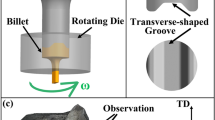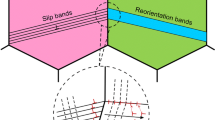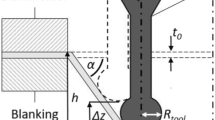Abstract
The texture evolution of copper tube manufactured by floating plug drawing process was investigated by Electron Backscatter Diffraction techniques and Visco-Plastic Self-consistent (VPSC) modelling method. The results obtained from experimentation indicate that the initial textures of copper tube transformed sharply after the first pass of the drawing process, and the final textures in the tube consist of Goss {110} <001> and P {110} <111> components. The VPSC model was established in order to study the texture transformation and the activity of slip systems of the tube during the drawing process. Two types of transformation paths were proposed to explain the mechanism of the texture evolution, which has a good agreement with the VPSC simulation results.
















Similar content being viewed by others
References
Toth LS, Lapovok R, Molotnikov A et al (2010) Texture evolution during micro-drawing of ultrafine grained copper. Mater Sci Eng A 527:4633–4640
Vincent K, Kiat JM, Janolin PE et al (2017) Crystallographic textures. European Physical Journal Conferences 155:00005
Chen LW, Han B, Shi QN et al (2010) Unformity of texture microstructure of pure copper sheets with severe plastic deformation. Mater Sci Technol 18(3):391–394
Konkova T, Valeev IS, Mironov S et al (2016) Microstructure response of cryogenically-rolled cu-30Sn brass to electric-current pulsing. J Alloys Compd 659:184–192
Li R, G, Zhang SJ, Kang HJ (2017) Microstructure and texture evolution in the cryorolled CuZr alloy. J Alloys Compd 693:592–600
Hirsch J, Lucke K (1988) Mechanism of deformation and development of rolling texture in polycrystalline FCC metals. Acta Metall 36:2863–2927
Zhao ZL, Li Z, Xiao Z (2017) Structure evolution of cu-3.6%Al2O3 alloy fine wire during cold drawing. Chin J Nonferrous Met 27(3):486–493
Pardis N, Chen C, Brahimi RE et al (2015) Microstructure, texture and mechanical properties of cyclic expansion–extrusion deformed pure copper. Mater Sci Eng A 628:423–432
Hörnqvist M, Mortazavi N, Halvarsson M et al (2015) Deformation and texture evolution of OFHC copper during dynamic tensile extrusion. Acta Mater 89:163–180
Zhang SH, Liu JS, Cheng M (2016) Cast and roll technology of precision copper tubes. National Defend Industry Press, Beijing
Um KK, Lee DN (1997) An upper bound solution of tube drawing. J Mater Process Technol 63(1–3):43–48
Sawamiphakdi K, Lahoti GD, Kropp PK (1991) Simulation of a tube drawing process by the finite element method. J Mater Process Technol 27:179–190
Techn J D, Benny E (2009) LS-DYNA used to analyze the drawing of precision tubes. 7th European LS-DYNA conference
Świątkowski K, Hatalak R (2004) Study of the new floating-plug drawing process of thin-walled tubes. J Mater Process Technol 151(1–3):105–114
Karnezis P, Farrugia DCJ (1998) Study of cold tube drawing by finite-element modelling. J Mater Process Technol 80:690–694
Mineur M, Villechaise P, Mendez J (2000) Influence of the crystalline texture on the fatigue behavior of a 316L austenitic stainless steel. Mater Sci Eng A 286(2):257–268
Shi Y, Jin H, Wu PD et al (2017) Analysis of roping in an AA6111 T4P automotive sheet in 3D deformation states. Acta Mater 124:598–607
Gregory JK, Brokmeier HG (1995) The relationship between crystallographic texture and salt water cracking susceptibility in Ti-6Al-4V. Mater Sci Eng A 203(1–2):365–372
Foadian F, Carradó A, Brokmeier HG et al (2019) Evolution of texture in precision seamless tubes investigated by synchrotron and neutron radiation measurement. Mater Charact 151:582–589
Tomé RA, Lebensohn CN (1993) A selfconsistent approach for the simulation of plastic deformation and texture development of polycrystals: application to zirconium alloys. Acta Metall Mater 41:2611–2624
Kyu Hwan O (1998) Analysis of texture evolution in FCC metals by full constraint and a self-consistent viscoplastic model. Met Mater Int 4(6):1127–1131
Kyu Hwan O (1999) Analysis of texture evolution of cubic metals by isotropic and anisotropic viscoplastic self-consistent models. Met Mater Int 5(1):17–23
Molinari A, Canova G, Ahzi S (1987) A self-consistent approach of the large deformation polycrystal viscoplasticity. Acta Metall 35:2983–2994
Lebensohn R, Tomé C (1993) A self-consistent anisotropic approach for the simulation of plastic deformation and texture development of polycrystals: application to zirconium alloys. Acta Metall Mater 41:2611–2624
Eshelby JD (1957) The determination of the elastic field of an ellipsoidal inclusion, and related problems. Proc Royal Soc Lond A 241:376–396
Asaro RJ, Needleman A (1985) Texture development and strain hardening in rate dependent polycrystals. Acta Metall Mater 33:923–953
Lebensohn R A, Turner P A, Signorelli J W et al (1998) Calculation of intergranular stresses based on a large strain visco-plastic self-consistent model. Model Simul Mater Sci Eng 6:447–465.
Lebensohn R A, Tomé C N, Ponte C P (2007) Self-consistent modeling of the mechanical behavior of visco-plastic polycrystals incorporating intragranular field fluctuations. Phil Mag 87:4287–4322.
Wang H, Raeisinia B, Wu PD et al (2010) Evaluation of self-consistent polycrystal plasticity models for magnesium alloy AZ31B sheet. Int Solids Struct 47:2905–2917
Hutchinson JW (1976) Bounds and self-consistent estimates for creep of polycrystalline materials. Proc R Soc London A 348:101–121
Masson R, Bornert M, Suquet P et al (2000) An affine formulation for the prediction of the effective properties of nonlinear composites and polycrystals. J Mech Phys Solids 48:1203–1227
Lebensohn R A, Tomé C N, Maudlin P J (2003) An extended self-consistent visco-plastic formulation: application to polycrystals with voids. Int Report of Los Alamos Natl Lab LA-UR-03-1993
Lebensohn RA, Tomé CN, Maudlin PJ (2004) A self-consistent formulation for the prediction of the anisotropic behavior of visco-plastic polycrystals with voids. J Mech Phys Solids 52:249–278
Molinari A, Tóth LS (1994) Tuning a self-consistent visco-plastic model by finite element results. Part I: modeling. Acta Metall Mater 42:2453–2458
Tomé CN (1999) Self-consistent polycrystal models: a directional compliance criterion to describe grain interactions. Model Simul Mater Sci Eng 7:723–738
Li B, Zhang SH, Zhang GL et al (2007) Microstructure simulation of copper tube and its application in three roll planetary rolling. Mater Sci Technol 23(6):715–722
Li B, Zhang SH, Zhang HQ et al (2007) Microstructure and properties of copper tube during three-roll planetary rolling. J Mater Eng Perform 17(4):499–505
Roohollah J (2017) Unexpected cube texture in cold rolling of copper. Mater Lett 202:111–115
Lapeire L, Sidor J, Verleysen P et al (2015) Texture comparison between room temperature rolled and cryogenically rolled pure copper. Acta Materialia 95:224–235
Tome C, Canova G R, Kocks U F et al (1984) The relation between macroscopic and microscopic strain hardening in FCC polycrystals. Acta metal 32(10):1637–1653
Valiev R Z, Alexandrov I V, Zhu Y T, Lowe T C (2002) Paradox of strength and ductility in metals processed by severe plastic deformation. J Mater Res 17(1):5–8
Acknowledgements
The authors would like to express their appreciation to the support by the National Natural Science Foundation of China under Grant No.51875547, and the Guangdong Long-feng Precise Tube Co., Ltd. for supplying experimental materials in the present study.
Author information
Authors and Affiliations
Corresponding author
Ethics declarations
Conflict of interest
The authors declare that they have no conflict of interest.
Additional information
Publisher’s note
Springer Nature remains neutral with regard to jurisdictional claims in published maps and institutional affiliations.
Rights and permissions
About this article
Cite this article
Wang, SW., Chen, Y., Song, HW. et al. Investigation of texture transformation paths in copper tube during floating plug drawing process. Int J Mater Form 14, 563–575 (2021). https://doi.org/10.1007/s12289-020-01538-z
Received:
Accepted:
Published:
Issue Date:
DOI: https://doi.org/10.1007/s12289-020-01538-z




